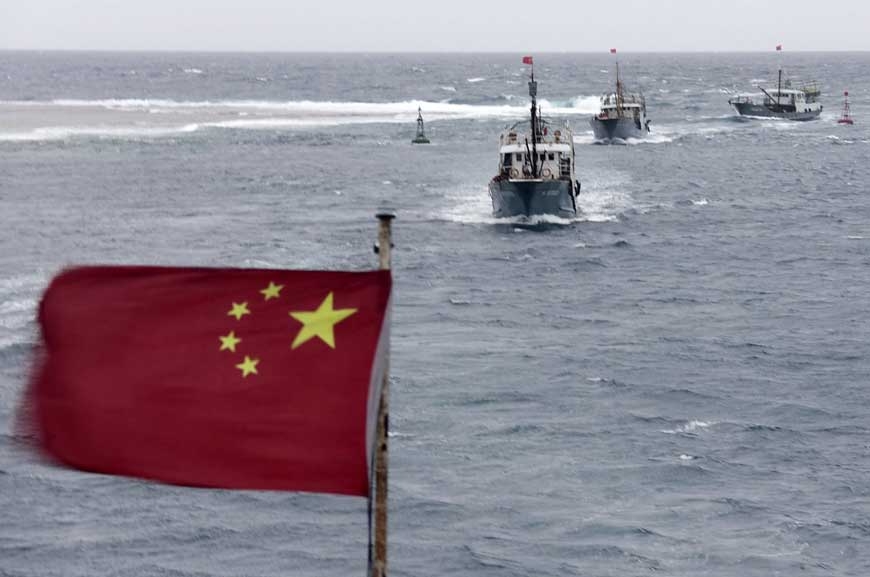
After the US started anew its patrol in the South China Sea at the end of May, Secretary of Defense James Mattis made a high-profile appearance at the 2017 Shangri-La IISS Asia Security Dialogue in Singapore on June 3. During the event, he spoke on the positions of the US new administration with respect to the South China Sea, including continued involvement in Asia-Pacific affairs, continued criticism of China’s island-building and determined pursuit of the “freedom of navigation” principleFor quite a while after Donald Trump assumed office last January, the impression his administration sent to the global community was that it had not yet formulated a clear-cut South China Sea policy. But from its latest moves of sanctioning a patrol program in South China Sea followed by a major policy announcement at SLD, we may conclude that a new US South China Sea policy has taken shape.
Renewing naval patrols in South China Sea, an intentional move?
On May 25, the US Burke-class destroyer Dewey entered the waters adjacent to the Meiji Reef of China’s Nansha Islands in a move to exercise, as it claimed, the navigational rights under international law. It is the first time for this to happen under the Trump administration. Yet the timing and the location of such a patrol - after turning down Pentagon requests three times and targeting China’s Meiji Reef – all smacks of a well-calculated intentional move.
First about the timing. Starting in May, the completion of a draft code of conduct by China and ASEAN and the launch of the bilateral consultation between China and the Philippines on the South China Sea issue reinforced the continued cooling-off in the situation there. The US, however, is loath to see ASEAN countries getting too close to China and, by stoking tensions there, it may impress its allies and partners with its awesome military presence while pressing China to go along with its policy on the Korean nuclear issue. What is more, having the patrol renewed right at the eve of the Shangri-La Dialogue may sensitize the South China Sea issue and prepare ground for likely China-bashing when crowds gather.
Second, about the location of the renewed patrol. China’s Meiji Reef, Yongshu Reef and Zhubi Reef, each having a 3,000-meter runway, have become important strategic outposts for China to conduct maritime cooperation in South China Sea and to manage and control changes in maritime situation there. The US military has already targeted Zhubi and Yongshu in previous patrols. Choosing Meiji this time may represent a US attempt to test China’s South China Sea policy. At the same time, echoing the finding that the Meiji Reef is a “low-tide elevation” by the notorious 2016 arbitration, the renewed patrol aims to challenge China’s territorial sovereignty and maritime rights and interests in South China Sea.
The US seems to have a new South China Sea policy.
Judging from Mattis’ Dialogue speech, we can conclude that this administration’s Asia-Pacific policy is by and large a continuation of the “rebalancing” strategy of the Obama administration. That is to preserve the political and military presence of the United States in Asia-Pacific, consolidate its alliance and partnership networks there and maintain its domination and leadership in the region. The new policy, specifically speaking, contains “two constants” and “two changes”.
The first constant is seen in the policy’s fundamental goal. Obama’s “rebalancing” strategy, Trump’s “America First” campaign slogan and Mattis’ SLD speech all make US fundamental interests in the Asia-Pacific region the top priority, which include maritime supremacy, domination of regional affairs and US leadership.
The other constant is seen in the policy’s chosen target, as the US still regards China as its geopolitical rival. In his Dialogue speech, Mattis continued to lash out at China’s island-building activities, describing them as encroaching on the interests of international community and violating the rule-based international order.
The first change, however, is that the Trump administration no longer treats the South China Sea as a burning priority. The 2017 US-Philippines “side-by-side” military exercise took place at the east side of the northern Luzon Island. Pentagon turned down the request for renewed South China Sea patrols three times. Mattis’ Dialogue speech, though still criticizing China, listed the Korean nuclear issue and the issue of terrorism as priority items to address immediately. This shows that to the Trump administration facing multiple troubles at home and abroad, the South China Sea clearly is no longer a foreign policy imperative.
Another change is seen in US tactics in intervening in the South China Sea. During the Obama presidency, the US stepped up introduction of military assets and conduct of military activities in the South China Sea region. Now, the US seems to put more emphasis on its interaction and cooperation with allies while urging them to shoulder greater political and security obligation in this regard.
China should play it cool.
For the US, continued domination in Asia-Pacific serves its fundamental interests, so it will never contemplate a withdrawal from the geopolitical gaming in South China Sea. Nor will it give up its “freedom of navigation” program. Therefore, the South China Sea patrol is not an issue of “to do or not to do”, but one of timing. In the immediate future, based on the domestic and diplomatic challenges facing the Trump administration, we can predict that US South China Sea patrol will continue but with a measure of easing intensity. There is no need for China to be exceptionally worried, as the country can afford to take it easy and respond with calm and composure.
First, President Trump himself is now struggling with the “Russiagate” problem and the amount of attention he can spare to the South China Sea is limited. It is not likely that the issue will become a red-hot distraction to the American public. The Democrats, in particular, will jump at the opportunity offered by Russiagate to rally support when last elections cost them dearly in both the House and Senate.
Second, compared with the South China Sea, such pressing issues as Korean nuclear activity, Syria and terrorism will command much greater attention of the Trump administration. With the Korean nuclear issue being touch and go and the Republic of Korea being in a crucial political transition, Trump will find himself more in need of a helping hand from the Chinese.
Third, the principal facilitator of the “freedom of navigation” program in South China Sea, Admiral Harry Harris of the US Pacific Command, is likely to step down. This Japanese-American admiral known for his hardline approach to China has served for more than two years, since May of 2015. It remains uncertain how long he can hold on to the job after the change of administration in Washington.
As a matter of fact, at their April meeting at the Mar-a-Lago resort, the heads of state of China and the US had an extensive exchange of views on bilateral ties and major international and regional issues of mutual interest and reached extensive agreement. This fruitful meeting laid the basis for a positive development of China-US relations. In particular, it helps the two sides to stay in touch on critical regional issues and avoid miscalculations. The Mattis Dialogue speech gives us reason to believe that “freedom of navigation” may not be the totality of the US’ South China Sea policy or that of its Asia-Pacific strategy. China-US relations are still on the track of steady development.
China US Focus



